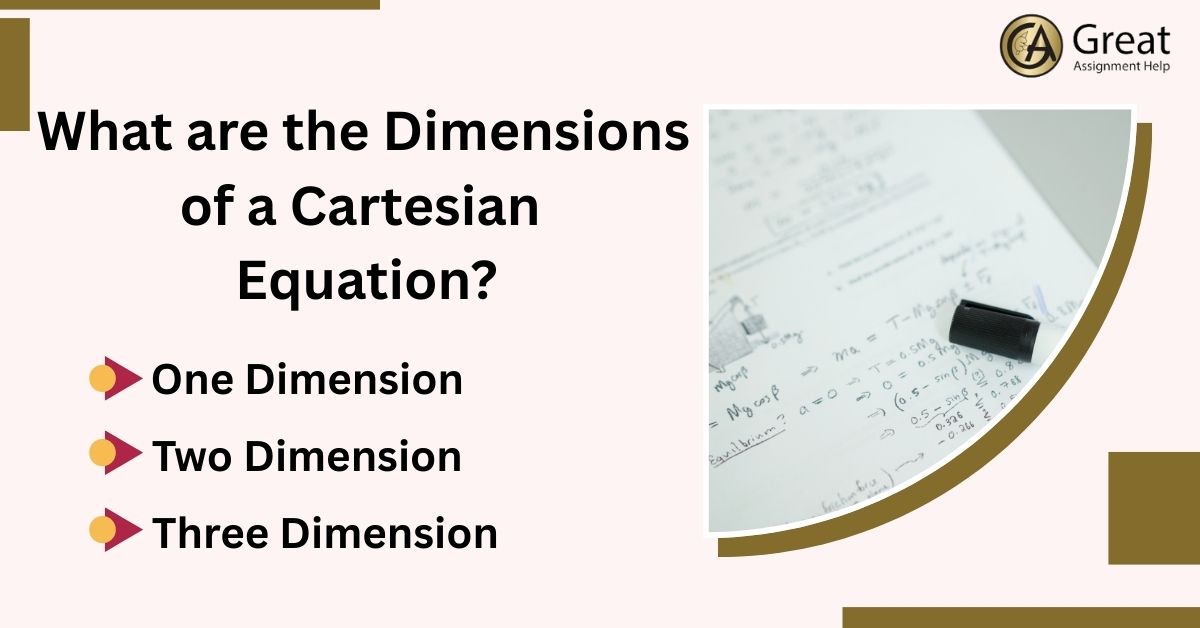A Cartesian equation is a way to mathematically express a relationship between two variables, x and y, on a graph. It will help you visualize and analyze different shapes and patterns. Especially by using a Cartesian equation, you can create lines, curves, and other geometric figures that represent real-world phenomena.
A Cartesian equation is a mathematical equation that describes the relationship between variables in terms of their coordinates on a Cartesian plane. This plane is a two-dimensional coordinate system that consists of a horizontal x-axis and a vertical y-axis to locate points in space. In the Cartesian coordinate system, each point is identified by an ordered pair of coordinates, (x, y). Here, x represents the horizontal distance from the y-axis, and y represents the vertical distance from the x-axis. The origin (0, 0) is the point where the two axes (x and y) meet. A Cartesian equation usually involves polynomials in x and y. The solutions to the equation are the points on the Cartesian plane where the equation is true. Read this blog to learn more about ‘what is a Cartesian Equation?’ Here, we have shared the definition, history, and formula of Cartesian equations with examples.
What is the Origin of Cartesian Equations?
The term “Cartesian” was coined by René Descartes, a French philosopher and mathematician, in 1637. Meanwhile, Pierre de Fermat discovered it independently, but didn’t publish his findings. Another mathematician, Nicole Oresme, had also used similar concepts centuries before Fermat and Descartes.
The Cartesian system has grown and become a key part of calculus, developed by Gottfried Wilhelm Leibniz and Isaac Newton. It uses a simple grid with two coordinates (x and y) to describe points on a plane. This idea has been extended and used in more advanced mathematical concepts, like vector spaces.
Definition of a Cartesian Equation
A Cartesian equation is a simple equation that uses x and y variables to draw a curve on a graph. However, sometimes it will be hard to find the equation of a curve. That is where parametric equations come in.
Parametric equations use a third variable, usually “t”, to help find the equation of a curve instantly. For example, if we have y = 4t, we can divide both sides by 4 to get (1/4)y = t.
This will help us find the equation of the curve more easily. Typically, parametric equations are useful for drawing curves and surfaces on a graph using their Cartesian coordinates (x, y).
Examples of Cartesian Equations
For your better understanding, below we have presented two Cartesian Equation examples
Example 1: Converting Parametric Equations
Given parametric equations:
x = 2 + t^2
y = 4t
To convert to a Cartesian equation:
- Solve for t: y = 4t → t = (1/4)y
- Substitute t into x equation: x = 2 + (1/4(y))^2
- Simplify: x = 2 + 1/16 y^2
- Rearrange to standard form: y = √(16x – 32)
Example 2: Equation of a Circle
The equation of a circle with center (2,3) and radius 4 is:
(x -2)^2 + (y-3)^2 = 16
This equation represents all points (x, y) on the circle.
- (x-2)^2 measures the horizontal distance between the point and the circle’s center..
- (y-3)^2 measures the vertical distance between the point and the circle’s center.
- The sum of these distances equals the radius squared (16)
The Importance of Cartesian Equations
Cartesian equations are a fundamental tool in mathematics. The Cartesian equations are widely used in areas such as algebra, geometry, calculus, and physics. Furthermore, they also help to describe and analyze relationships between variables. Therefore, it is considered to be a crucial concept in modern mathematics.
What are the Dimensions of a Cartesian Equation?

The Cartesian coordinate system is a fundamental concept in mathematics that allows us to represent points in space using numerical coordinates. This system is applicable in various dimensions, including one, two, and three dimensions.
One Dimension
In a one-dimensional space, the Cartesian coordinate system is established by:
- Selecting a point O as the origin on a straight line
- Choosing a unit of length
- Defining an orientation for the line (i.e., determining which direction is positive and which is negative)
This one-dimensional Cartesian system is commonly referred to as the number line. Every real number has a corresponding location on this line, and each point on the line can be associated with a real number.
Two Dimension
In two-dimensional space, the Cartesian coordinate system consists of:
- Two perpendicular axes (x-axis and y-axis)
- A common origin point (O) where the axes intersect
- A unit of length for both axes
- An orientation for each axis
This two-dimensional Cartesian system enables us to represent points on a plane using ordered pairs of coordinates (x, y).
Three Dimension
In three-dimensional space, the Cartesian coordinate system comprises:
- Three mutually perpendicular axes (x-axis, y-axis, and z-axis)
- A common origin point (O) where the axes intersect
- A unit of length for all three axes
- An orientation for each axis
In this three-dimensional Cartesian system, points in space are represented using ordered triples of coordinates (x, y, z).
What is the Cartesian Equation Formula?
Cartesian equations are mathematical representations of relationships between variables in different dimensions. Here are the key formulas:
3D Space: Plane Equation
The Cartesian equation for a plane in three-dimensional space is:
Ax + By + Cz + D = 0
where
A, B, C, and D are constants
x, y, and z are variables representing points in 3D space
2D Space: Linear Equation
In two-dimensional space, the Cartesian equation for a straight line is:
y = mx + c
where:
m is the slope (gradient) of the line
c is the y-intercept (the point where the line crosses the y-axis)
x and y are variables representing points on the line
Application of a Cartesian Equation
To use Cartesian coordinates in a practical scenario, consider the following three key steps:
- Define the Reference Point: Assign a specific location or landmark as the origin.
- Set the Scale: Determine the units of measurement to represent distances.
- Establish Orientation: Use available directional cues to define the orientation of the axes, leaving one pair’s orientation to be determined.
Final Words
By now, you will have learned what a Cartesian equation means. In summary, the Cartesian equation is a mathematical representation of geometric shapes like lines, circles, and curves using algebra. It uses a 2D coordinate system with x and y axes to pinpoint locations as (x, y) pairs. A Cartesian equation typically combines x and y in an algebraic expression, such as y = mx + b for lines, or x^2 + y^2 = r^2 for circles. By plotting points that satisfy these equations, you can visualize the corresponding geometric shapes.
If you are still not clear what a Cartesian equation is and are unsure how to solve mathematical problems related to it, call us. The Math assignment experts from our platform will guide you in applying the Cartesian equation formula and accurately solving problems based on it.



